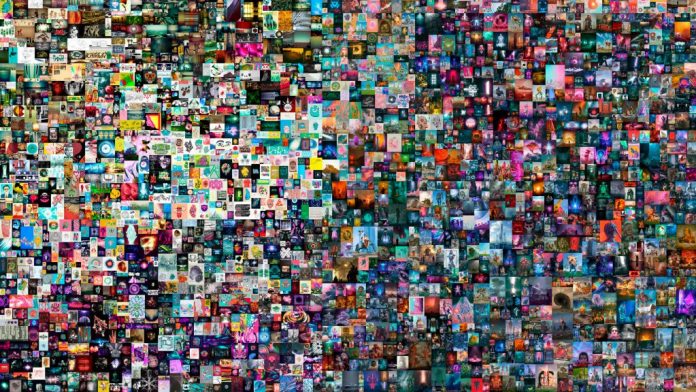Auction houses like Christie’s and Sotheby’s regularly auction off renaissance art for millions of dollars. Work by 20th century masters like Picasso, Basquiat, Rothko and Kandinsky can sell at prices in the seven- or eight-digit range as well.
And contemporary art, with all of its eccentricities, catches a fair price on the auction block – who can forget “Girl With a Balloon,” the painting by counterculture street artist Banksy, which infamously self-destructed after the gavel dropped on a $1.4 million sale?
But now, thanks to blockchain technology, there’s something new and very different on the collectible art auction block: “Crypto art.”
While crypto art has been around in various forms since 2015, the medium made a huge splash last week at Christie’s in New York as “Everydays: The First 5,000 Days” by Beeple sold for $60.25 million at auction, which cost the buyer $69 million when Christie’s buyer’s premium is included. That makes “Everydays” as the most valuable piece of digital art to be sold at auction thus far.
Crypto art is non-physical art developed as a non-fungible token (NFT), a blockchain-supported digital certificate of authentication. The buyer, who goes by the pseudonym Metakovan, didn’t take home any physical representation of the artwork – no canvas, no frame, no box, no marble or bronze – because “Everydays” exists purely in digital form. Metakovan definitely wasn’t surprised by this, as he’s one of the funders behind Metapurse, a NFT fund.
According to Bloomberg, Christie’s was “90% sure” that the sale, including the buyer’s premium, would be paid for with cryptocurrency.
An NFT uses blockchain to enable someone to purchase and authenticate their right to something unique – while it’s most stunning application to date has been in the world of digital art, it’s also been used for videogame elements like property, items and equipment, virtual property like spaces in Second Life, and other collectibles. Unlike cryptocurrency tokens, which are fungible – meaning they can be easily exchanged and each one is identical to the next – NFT’s are unique.
Also, the NFT represents ownership of the work, not the work itself – so art represented by the NFT can be copied and reproduced with the artist’s blessing, since copyright still technically resides with the artist or creator of the content themselves. Thus, the art world provides a useful lens to understand how NFTs work, as a print of a baroque or renaissance masterwork can be reproduced and sold millions of times, while the original work only resides in one location.
NFTs include metadata, file links, owner identification and other information that make each token unique. The twist is that NFTs can include royalties features that allow the original artist to be paid a percentage of price whenever their work is resold or reproduced.
Beeple is the nom du plume of Charleston, South Carolina-based Mike Winkelmann, and “Everydays” is a collage of all of his work since 2013. Winkelmann began offering his digital art for sale as NFTs in the second half of last year, but this is his first piece to break the million-dollar mark in a sale.
In 2012, the idea got its start in Bitcoin’s “Colored Coins,” which were merely satoshis marked with information linking them to specific real-world assets. In 2015, what may be the first real NFT, Etheria, was launched on the Ethereum blockchain as a map of tradable tiles upon which structures could be built. It went relatively unnoticed for years until over the past couple of days, as interest in NFTs surged, and buyers scooped up its remaining tiles.
NFT development really didn’t start to take hold until 2017, when a series of collectible concepts, possibly starting with a set of collectible characters called CyberPunks, were released as tokens using Ethereum’s ERC-721 NFT standard. The space further matured over the next 12 months as NFT exchanges and marketplaces were developed, like Rarible, OpenSea and Nifty Gateway.
Now NFTs are being applied in a number of different ways – NBA Top Shot creates NFTs around moments from NBA games as digital collectible cards. Classic video game company Atari launched it own set of NFTs, representing the box art from its vintage games, in November of last year. Topps, the tobacco and chewing gum company turned collectible card maker, converted its Garbage Pail Kids trading cards into NFTs in May of 2020. In July 2020, William Shatner sold Shatner-themed trading cards as NFTs. In February of this year, Grimes, musician and girlfriend to Tesla founder Elon Musk, sold $5.8 million of art via Nifty Gateway.
Not one to be left behind, on Monday, Elon Musk himself said that he was going to sell a song as an NFT.
Where is all this going? Music and movies are likely to be supported and in part sold as NFTs in the future. NFTs are already being created that represent social media presences and posts. They’re also being used to represent real-world collectibles and unique investments like sneakers, race horses and NFTs are also likely to play a role in the future of decentralized finance as artists and other producers seek to circumvent traditional marketplaces – and, as Beeple has shown all of us, NFTs are likely to have a place in traditional marketplaces as well.
But some of the current frenzy around NFTs may also be driven by the pandemic — around the world, people with plenty of disposable assets have few experiences on which to spend their money, so the recent focus has been on assets, both fungible, like the meme stocks pumped on Reddit and dumped on Robinhood, and non-fungible, like “Everydays.”
One common criticism of NFTs in their current form is the amount of energy it takes to support their underlying blockchain. NFTs operate off of a proof-of-work (PoW) blockchain, usually Ethereum’s, which is far more energy intensive than a proof-of-stake blockchain (PoS) – yet, to this day, most major cryptocurrencies continue to run off of PoW.
While Ethereum seems to be the blockchain of choice for most NFTs thus far, there are other blockchain developers now offering NFTs, such as Binance, WAX and TRON, the blockchain of Chinese BitTorrent founder Justin Sun, and there are likely to be more in the future.
On Twitter, Sun said that happened to be the second-highest bidder for “Everydays.”







